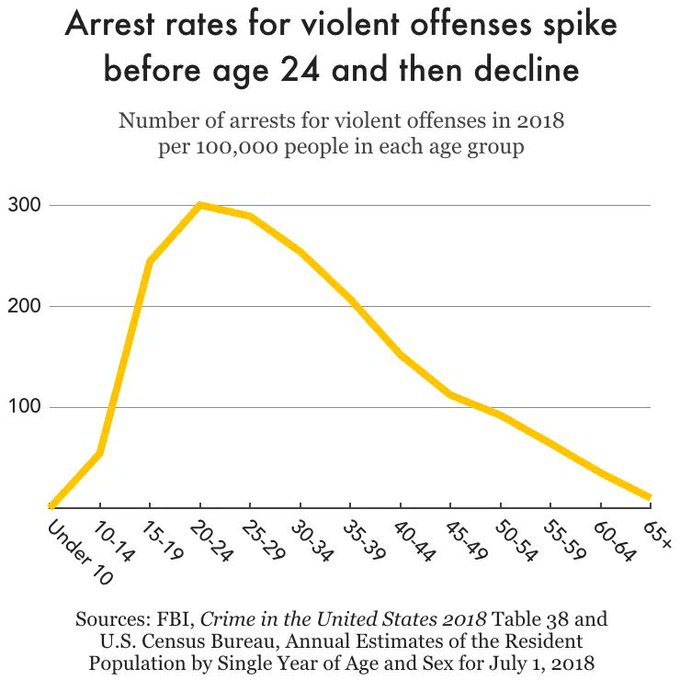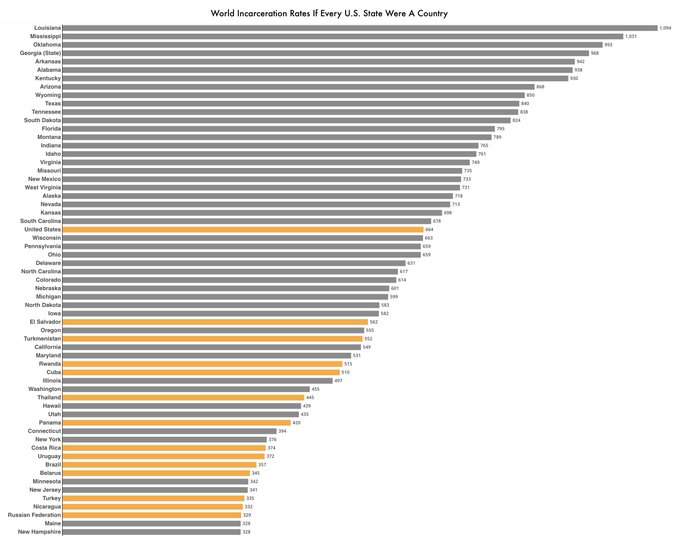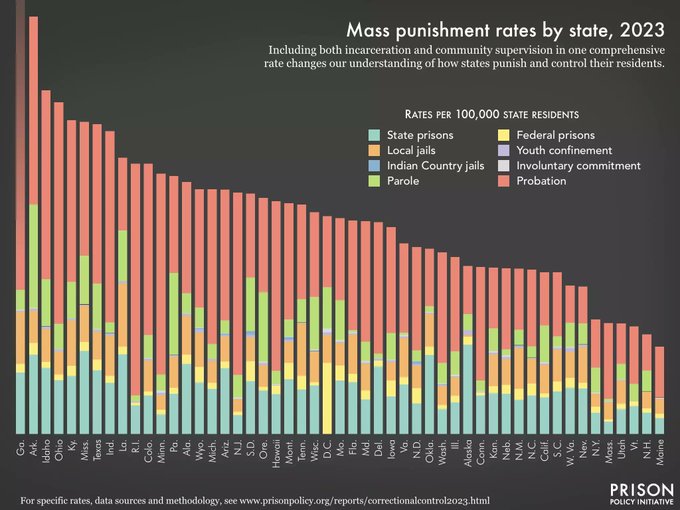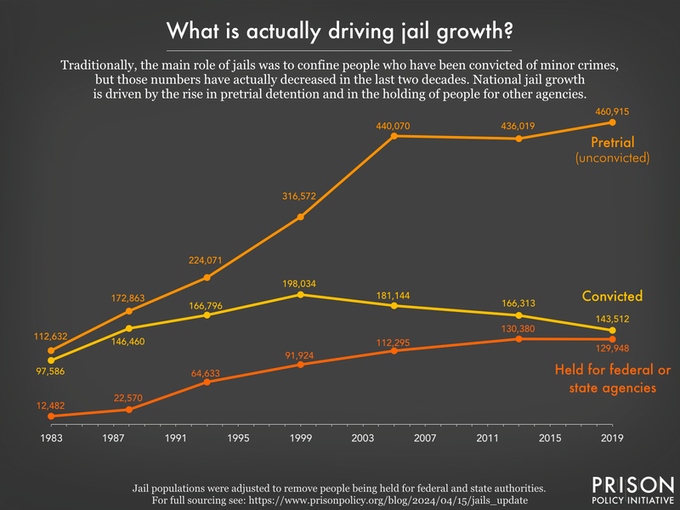
Prison Policy Initiative
@PrisonPolicy
Followers
74,944
Following
3,970
Media
2,370
Statuses
15,514
Challenging mass incarceration and over-criminalization through research, advocacy, and organizing. Get email updates:
Easthampton, MA
Joined October 2009
Don't wanna be here?
Send us removal request.
Explore trending content on Musk Viewer
Garbage
• 2132006 Tweets
ハロウィン
• 1177937 Tweets
Valencia
• 968461 Tweets
DANA
• 760177 Tweets
Happy Halloween
• 249605 Tweets
ポケポケ
• 162301 Tweets
Trick or Treat
• 122336 Tweets
#週刊ナイナイミュージック
• 118081 Tweets
RTVE
• 110485 Tweets
イタズラ
• 70596 Tweets
SCOTUS
• 47627 Tweets
Rachel Reeves
• 46321 Tweets
#Budget2024
• 42844 Tweets
Arnold
• 40478 Tweets
橋本環奈
• 38390 Tweets
SÃO PAULO TODAY
• 35741 Tweets
ベイスターズ
• 33258 Tweets
トリックオアトリート
• 30708 Tweets
ミュウツー
• 25075 Tweets
Jerez
• 24384 Tweets
OVER THE MOON TEASER 1
• 24351 Tweets
#JO1ANNX
• 21135 Tweets
GALA EN LA MEJOR
• 20212 Tweets
Rishi
• 18816 Tweets
横浜優勝
• 17422 Tweets
Sunak
• 17112 Tweets
ハマスタ
• 17057 Tweets
해피 할로윈
• 16357 Tweets
ウォーターマーク
• 15933 Tweets
La Palma
• 14373 Tweets
ミュージカル組
• 12933 Tweets
Last Seen Profiles
Claim
#2
: "Crime is out of control."
Response:
Crime remains at historically low levels.
The perception that crime is up is driven by hyperbolic media coverage and claims by opportunistic elected officials.
Property crime is at its lowest level in more than 30 years.
13
524
3K
Claim
#1
: "Crime is up because of bail reform!"
Response:
Very few places have actually eliminated or reduced their dependence on money bail.
In those places that have reined in their money bail system, most saw decreases or negligible increases in crime after reforms...
9
265
3K
Claim
#3
: "Crime is up because we defunded the police."
Response:
Very few cities actually defunded the police. In a small subset of these, crime went up slightly this year, but this is likely related to the pandemic and economic hardships. (continued)
7
253
2K
Claim
#5
: "Sometimes jail or prison is the best place for someone - they can get the help they need."
Response:
Even in the best of times, jails and prisons are not good at providing health and social services, such as substance use and mental health treatment.
7
212
1K
Claim
#4
: "Tons of people were released from prison during the pandemic."
Response:
While prison and jail populations did drop early in the pandemic, this isn't due to releases. Prisons actually released fewer people in 2020 than in 2019.
2
200
1K
Claim
#7
: “If you were a victim of crime, you’d want to lock them up and throw away the key."
Response:
Crime victims overwhelmingly support things like investing in mental health & drug treatment, and expanding violence prevention & youth programs, over more incarceration.
5
204
1K
Claim
#6
: "Reforms for ‘nonviolent offenders’ are fine, but violent offenders need to stay locked up for public safety."
Response:
Research shows people convicted of violent offenses are not inherently violent... (continued)
4
139
1K
Sadly, formerly incarcerated people are 10x more likely to be homeless than the general public.
This makes them more likely to be arrested & incarcerated again, thanks to policies & directives like THIS that criminalize homelessness.
3
298
497
Claim
#2
: “We need to crack down on homelessness.”
Response: Rather than criminalizing homelessness, we need to make it easier for people to secure and maintain housing, particularly as they deal with other challenges.
2
47
487
"Free room and board" is a fallacy. Even basic needs aren't free for incarcerated people - and prisons, we found, are means-testing financial assistance to only serve the absolute poorest:
9
271
459
🚨BREAKING: The
@FCC
just voted to slash prison & jail calling rates and ban corporate kickbacks to prisons and jails – a major victory for incarcerated people and their loved ones!
#PeopleOverProfit
9
194
460
Claim
#1
: “Crime is out of control.”
Response: The belief that crime is increasing is driven by self-serving politicians. The facts tell a different story.
2
30
442
Violent crime rates are ½ of what they were 30 years ago. Property crime rates are also at historic lows & have fallen by 32% in just the last 10 years. (Thanks
@BrennanCenter
@AmesCG
for the charts.)
3
53
428
Rather than trivializing what billionaire 'Diddy' has access to behind bars, it's important to remember that most incarcerated people have little to their name & are forced to spend the money they do have on basic necessities.
Commissary is an extremely exploitative system.
9
97
396
If jails and prisons are going to suspend in-person visits because of the coronavirus, they MUST make video visits and phone calls free.
The alternative - isolating incarcerated people from their families - is inhumane and dangerous.
WE NEED YOUR HELP:
Ulster Co. jail suspended in-person visits. Now, families can only stay connected if they pay $3.22 for a 15 min. call.
Tell
@UlsterCoSheriff
to make calls free. This is a crisis, not a business opportunity.
#ConnectingFamilies
3
90
151
10
211
380
Claim
#3
: “Sometimes jail is the best place for someone - they can get the help they need.”
Response: This might be a well-intentioned statement, but it’s not true. Prisons and jails are NOT good at providing substance use/mental health treatment, or any chronic medical care.
4
41
365
It's not just Sandra Bland: Women have experienced a 353% increase in police use of force (and threats of force) since 1999, an even greater increase than men have experienced.
#SayHerName
4
325
335
In other words: 166,000 people are being put in solitary confinement for the next two weeks. The trauma this will inflict is unimaginable.
The choice cannot be between mass death and mass solitary confinement. We must release people to be with their families.
9
239
313
People striking in Alabama prisons are making clear policy demands. Our 2018 report "Eight Keys to Mercy: How to shorten excessive prison sentences" goes into detail on how lawmakers in AL - or any state - can make some of these demands a reality:
the strike inside Alabama prisons continues, with clear demands from incarcerated organizers. the DOJ's intervention has done nothing to shift conditions inside Alabama prisons; they remain incredibly unsafe, inhumane, and exploitative
#ShutDownADOC2022
7
315
481
2
194
315
If you're thinking about mass incarceration this
#Juneteenth2023
, consider the complete scope: not just 2 million people behind bars, but 3.5 million on probation and parole, systems that can replicate prison conditions in the community. 30% of people under supervision are Black.
16
237
298
Happy
#IndigenousPeoplesDay
, and a reminder that the legacy of centuries of oppression and theft from Native people is their vast overrepresentation in state prisons.
5
220
298









































































































